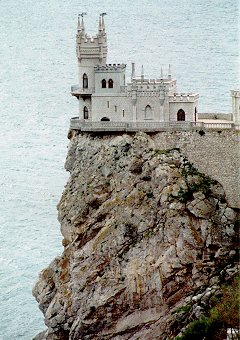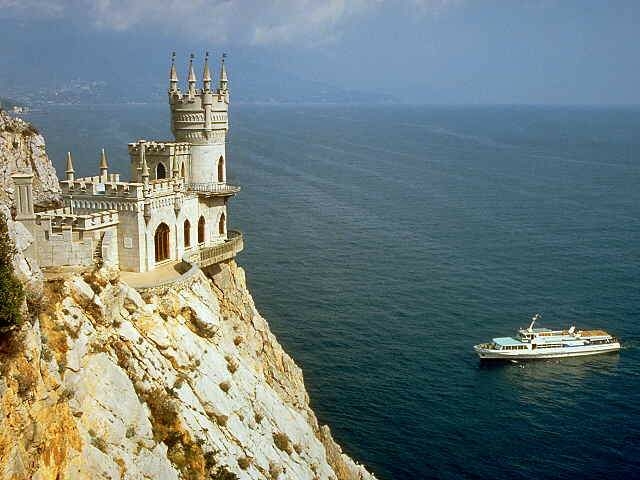Ukraine Today
Watch and Read about Ukraine Today

Ukraine information
Street view of Ukrainian cities on Google
Swallow's Nest Castle
The Swallow's Nest
 Romantic " ” castle on the Aurora cliffs of Cape Ai-Todor dominates the surrounding coastline. It was constructed in 1912 from the designs of architect A. V. Sherwood for Baron Von Shteingel, a Baku oilman. Nowadays it is the symbol of Crimea and a tourist destination practically for all foreign tourists that come to Yalta.
Romantic " ” castle on the Aurora cliffs of Cape Ai-Todor dominates the surrounding coastline. It was constructed in 1912 from the designs of architect A. V. Sherwood for Baron Von Shteingel, a Baku oilman. Nowadays it is the symbol of Crimea and a tourist destination practically for all foreign tourists that come to Yalta.
Local people believe that if to cast a coin from the cliff and make a wish before this coin reach the water this wish will come true. Swallow’s Nest is a special place. You can feel it when standing near the castle and looking from the cliff at the magnificent seascape.
The building is compact in size (20 m long by 10 m wide; 65 ft by 33 ft). Its original design envisioned a foyer, guest room, stairway to the tower, and two bedrooms on two different levels within the tower. The interior of the guest room is decorated with wooden panels; the walls of the rest of the rooms are stuccoed and painted. An observation deck rings the building, providing a view of the sea, and Yalta's distant shoreline.
The first building on the Aurora Cliff was constructed for a Russian general in 1895. The first building he built was a wooden cottage romantically named the "Love Castle". Later on, the ownership of the cottage passed to A. K. Tobin, a court doctor to the Russian Tsar.
In 1911, Baron von Steingel, a Baltic German noble who had made a fortune extracting oil in Baku, acquired the timber cottage and within a year had it replaced by the current building. The Scottish baronial and Neo-Moorish styles had been introduced in the Crimea in the 1820s by Lord Blore, the architect of the (1828-46). Compared to Alupka and Koreiz, Swallow's Nest is closer in style to German architectural follies, such as Neuschwanstein, Babelsberg, and Stolzenfels, although its precarious setting on the cliffs by the sea-side may also suggest the Belem Tower.
 In 1914, von Steingel sold the building to P. G. Shelaputin to be used as a restaurant. For a short time after the Russian Revolution of 1917, the building was used only as a tourist attraction. In the 1930s, the building was used by a reading club of the nearby Zhemchuzhina ("Pearl") resort house.
In 1914, von Steingel sold the building to P. G. Shelaputin to be used as a restaurant. For a short time after the Russian Revolution of 1917, the building was used only as a tourist attraction. In the 1930s, the building was used by a reading club of the nearby Zhemchuzhina ("Pearl") resort house.
In 1901 - 1902 L N. Tolstoi and A. M. Gorki frequented Oreanda. Here the marine artist I. K. Aivazovski painted Yalta.
In 1927, Swallow's Nest survived a devastating earthquake rated at 6 to 7 on the Richter scale. The building was not damaged, except for some small decorative items that were thrown into the sea along with a small portion of the cliff. However, the cliff itself developed a huge crack. For a long time Swallow's Nest was closed to the public due to the damage suffered in that quake. The building remained closed for almost forty years.
Renovation was started in 1968. The project involved restoration of a small portion of the castle and the addition of a monolithic console concrete plate to strengthen the cliff. Since 1975, an Italian restaurant has operated within the building. Swallow's Nest was also featured in several Soviet films. It was used as the setting of "Desyat' Negrityat", the Soviet screen version of Agata Christie's "And Then There Were Non"e.
Read more about



